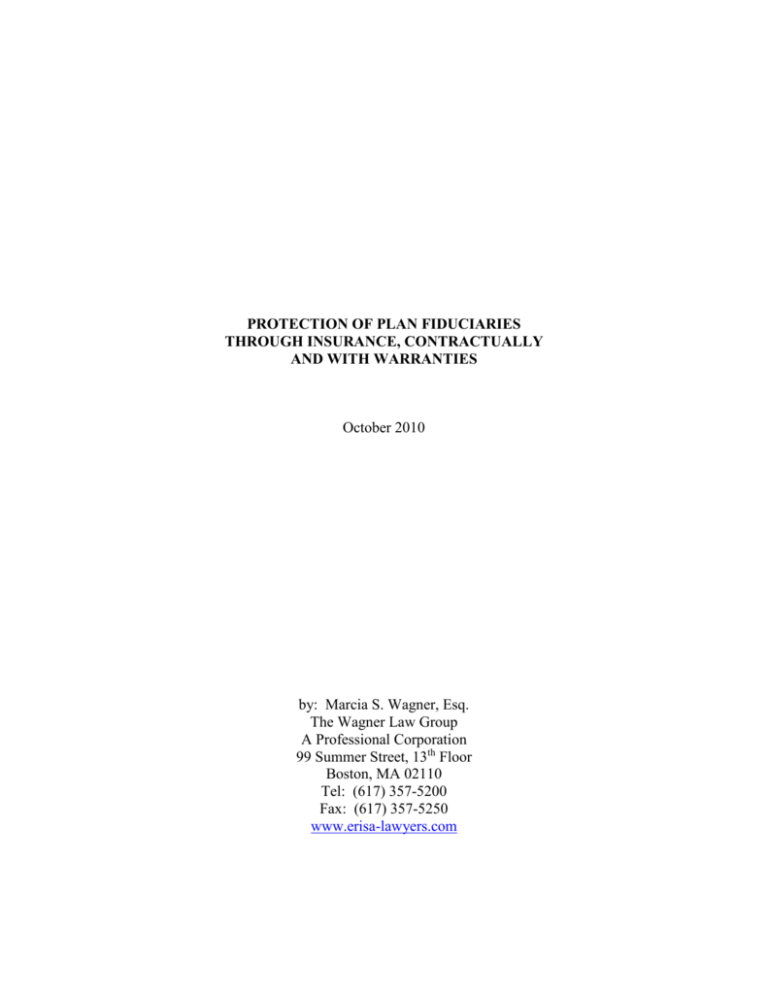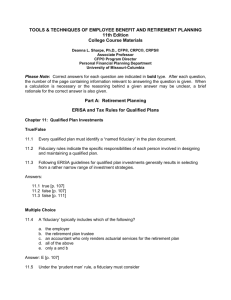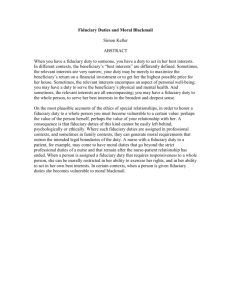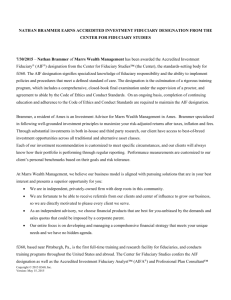Protection of Plan Fiduciaries through Insurance
advertisement

PROTECTION OF PLAN FIDUCIARIES THROUGH INSURANCE, CONTRACTUALLY AND WITH WARRANTIES October 2010 by: Marcia S. Wagner, Esq. The Wagner Law Group A Professional Corporation 99 Summer Street, 13th Floor Boston, MA 02110 Tel: (617) 357-5200 Fax: (617) 357-5250 www.erisa-lawyers.com PROTECTION OF PLAN FIDUCIARIES THROUGH INSURANCE, CONTRACTUALLY AND WITH WARRANTIES As the pension industry evolves and becomes more sophisticated and as risks to plan sponsors of being fiduciaries continue to grow, there are a few ways - some legally mandated, some being contractually negotiated - plan sponsors are using to help them mitigate their potential liability as plan fiduciaries. This paper discusses the following such arrangements: ERISA bonds, fiduciary liability insurance, professional liability insurance, contractual limitations on liability, and fiduciary warranties or guarantees. A. B. ERISA Bond. 1. Coverage. ERISA Section 412 requires bonding for every plan fiduciary and every person that handles funds or other property of the plan. The bond must provide protection to the plan against loss by reason of acts of fraud or dishonesty on the part of fiduciaries or plan officials handling plan funds or property. 2. Amount of Bond. The bond amount must be 10% of plan assets with a minimum of $1,000 and a maximum of $500,000. Effective for plan years beginning after December 31, 2007, the maximum bond amount will increase to $1 million for plan that hold employer securities. The increased maximum applies to every person required to be bonded, even if that person does not have any duties relating to employer securities. 3. Special Rule for Registered Brokers and Dealers. Entities that are registered as a broker or a dealer under Section 15(b) of the Securities Exchange Act of 1934 will be exempt from the bonding requirement, provided that they are subject to the fidelity bond requirements of a selfregulatory organization. This rule is effective for plan years beginning after August 17, 2006, the date of enactment of the Pension Protection Act of 2006. Fiduciary Liability Insurance. 1. Coverage. Pays the plan and/or insured fiduciaries for liabilities incurred as a result of a breach of fiduciary duties under ERISA, including the cost of defending claims. C. 2. Insureds. Generally, a trust or trustee of an employee benefit plan, the sponsoring employer, and any officer or employee of the trust, the plan, or the sponsoring employer. 3. Limitation. This type of insurance may be purchased either by the employer or by the plan. However, if the plan is the purchaser, Section 410 of ERISA requires that the policy permit recourse by the insurer against the fiduciary. This is consistent with the DOL’s position that arrangements for the indemnification of a fiduciary by the plan are void. However, the DOL allows a fiduciary to purchase, with the fiduciary’s own assets, elimination of recourse coverage. Professional Liability Insurance. 1. Coverage. This insurance would be sought by plan consultants and investment advisers and would cover claims for improperly administering a retirement plan as well as imprudent decisions or improper processes with respect to investment issues. It may also be referred to as errors and omissions insurance and may be part of a commercial general liability (CGL) package. The language of the policy should be read carefully to make sure that it covers the activities engaged in by the insured. 2 Exclusions. Most policies will come with an additional schedule or addendum known as an endorsement. Endorsements exclude certain types of claims from coverage. Example of such exclusions include: a. Claims arising out of the propriety or impropriety of compensation paid out of the plan for administrative services; b. Claims arising from late trading and market timing activities; c. Claims arising from soft dollar or revenue sharing arrangements. 3. Embedded Exclusions. Additional exclusions may be found embedded in the insurance policy, itself. These are harder to identify, but should not be ignored. For example, embedded exclusions frequently exclude commission related complaints. 4. Importance of Negotiation. Exclusions can often be modified or eliminated by negotiation, particularly if the insured has a good history with respect to a particular issue. For example, if you can demonstrate that your fees are consistent with fees charged by similar service The Wagner Law Group – Specializing in ERISA, Employee Benefits and Executive Compensation Law 2 providers, insurers will consider the elimination of the exclusion relating to claims arising out of compensation matters. Because of the rise in litigation over soft dollar and revenue sharing practices, an insurer will require detailed disclosure of your treatment of these matters before it limits or eliminates exclusionary language in this area. The assistance of a skilled broker is often vital in negotiating the terms of an exclusion. 5. D. Policy Limits. Attention should also be addressed to the sufficiency of dollar limits on policy coverage. A significant issue is whether the coverage of defense costs is outside the limits of the policy, since such costs can quickly exceed the policy coverage. Contractual Limitations on Liability. 1. Limitation on Liability Provisions. These provisions require a plan and/or employer to limit damages for causes of action against a service provider to a predetermined amount, typically equal to one year’s fee. 2. Indemnification of Service Providers. These provisions require the plan and/or the employer to indemnify and hold harmless a service provider from any third party claims or liability arising from or in connection with the service provider’s services to the plan. 3. DOL Position as Stated in Advisory Opinion 2002-08A. a. Fraud or Willful Misconduct. If the attempt to limit liability applies to fraud or willful misconduct by the service provider, it is void. In addition, a plan fiduciary’s acceptance of such limitations would violate ERISA’s prudence standards. b. Negligence or Unintentional Malpractice. Limitation of liability and indemnity provisions, other than those relating to fraud or willful misconduct, are not per se imprudent under ERISA’s general standards of fiduciary duty. c. Due Diligence Procedures. Since liability limitations related to negligence or unintentional malpractice may or may not be consistent with a plan fiduciary’s duties to the plan, the fiduciary should take the following steps: (i) Assess the reasonableness of the relationship as a whole. This should include a cost benefit analysis that compares The Wagner Law Group – Specializing in ERISA, Employee Benefits and Executive Compensation Law 3 the cost of service arrangements with other service providers that do not require such limits. (ii) E. The plan fiduciary should document the assessment made above in taking into account the potential risk of loss and costs to the plan that might result from a service provider’s act or omission that would be subject to a limitation of liability or indemnification provision. FIDUCIARY RELIEF MADE AVAILABLE BY INVESTMENT PROVIDERS 1. Analysis of Guarantees. New programs offered by investment providers purporting to share or relieve fiduciary responsibilities of a plan sponsor focus on guiding a plan sponsor in choosing an investment line-up for a participant-directed 401(k) plan and generally take one of two approaches. The first approach is to utilize the services of a well-known, independent investment management or consulting firm that prepares a “suggested” or “premier” list of funds culled from the investment platform maintained by the mutual fund company or other investment provider. Provided that the plan sponsor selects the plan’s investment menu from this restricted list, the investment management or consulting firm either agrees to be a cofiduciary or otherwise acknowledges its fiduciary status with respect to the funds on the list. This is probably unnecessary, since the investment management or consulting firm has, in effect, recommended the funds on the restricted list to the plan sponsor for which it is paid by the mutual fund house or other investment provider. The investment management/consulting firm has, therefore, met the requirements for being an investment advice fiduciary under the DOL regulations. The fine print in such arrangements should be examined closely, because, in some cases, the inclusion of a single investment option not appearing on the approved list (or the deletion of a recommended investment option) purportedly renders the benefits of the program inapplicable. Further, even when all the requirements of the arrangement are met, the plan sponsor or other plan fiduciary may continue to bear exclusive responsibility for other fiduciary issues, including the determination as to whether the adoption of the program itself is well-suited to the plan. The program documentation may include a vaguely worded indemnification for claims arising out of a fiduciary breach, but the enforcement of such an indemnity may prove problematic. Moreover, some of the agreements provide for a cross-indemnity under which the plan sponsor could find itself indemnifying the investment management or consulting firm. The Wagner Law Group – Specializing in ERISA, Employee Benefits and Executive Compensation Law 4 The second approach to assisting plan sponsors with their fiduciary duties also involves providing a model list of investment options that includes investment vehicles from a broad range of investment categories. If the plan sponsor selects an investment line-up with representative investment vehicles from each of the recommended categories, the investment provider will guarantee that the plan sponsor’s choice meets certain (but not all) aspects of ERISA’s prudence requirement. The appropriate balance of risk and potential return, the exclusive benefit rule, diversification and numerous other fiduciary matters are not covered. These programs may also guarantee that the plan meets the broad range of investments requirement necessary to assert the Section 404(c) defense which relieves fiduciaries of liability where loss results from a participant’s exercise of direction and control of the investment of his own account. This guarantee is very limited and does not apply to other structural conditions of the 404(c) defense or to its numerous operational requirements. In the end, the new programs provide some assurance that if the recommendations are followed, a plan sponsor will have constructed a well balanced menu of investment options. Further, since the investment management or consulting firm, periodically monitors the funds on the approved list and reports its findings on a website, the plan sponsor receives assistance in meeting its ongoing fiduciary responsibilities. However, the transfer or sharing of fiduciary responsibility is somewhat illusory. As has been noted, fiduciary status depends on what the investment firm does, not on what it says. In that sense, the promises of the new programs do not add to the rights that a plan already possesses with respect to an investment provider. Moreover, the documentation of the new programs could actually have the effect of limiting liability resulting from the actions of an investment firm in recommending plan investment options. 2. Questions to Ask with Regard to Fiduciary Relief Programs. In light of their restrictions and the less than fully transparent nature of how they are paid for, plan sponsors and their advisers should consider asking the following questions of those offering guarantees of a fiduciary nature: • Can you explain the standards by which your conduct will be governed when you state that you will act as a fiduciary? • Please specify those aspects of ERISA’s prudence requirement that are not covered by this program. • Will you reimburse the plan for investment losses incurred as a result of the imprudent inclusion of an investment option on the recommended list? Are there any other circumstances under which you would assume liability for a fiduciary breach? The Wagner Law Group – Specializing in ERISA, Employee Benefits and Executive Compensation Law 5 • Are there any circumstances under which you will assert the right to be indemnified by the plan or plan sponsor? • Explain how your fees for providing services under this program are determined? • What fees do you or your affiliates receive with respect to investment products that are included on the recommended list? • What arrangements have been made to notify the plan sponsor between quarterly reporting periods that events have occurred warranting the removal of an investment option from a plan’s investment line-up? K:\99995\A0043724.DOC The Wagner Law Group – Specializing in ERISA, Employee Benefits and Executive Compensation Law 6


![Mark Whitenack Digital Assets PowerPoint Presentation []](http://s2.studylib.net/store/data/005383425_1-9cf830a5f2e9fc777daa963eb9460c8e-300x300.png)




